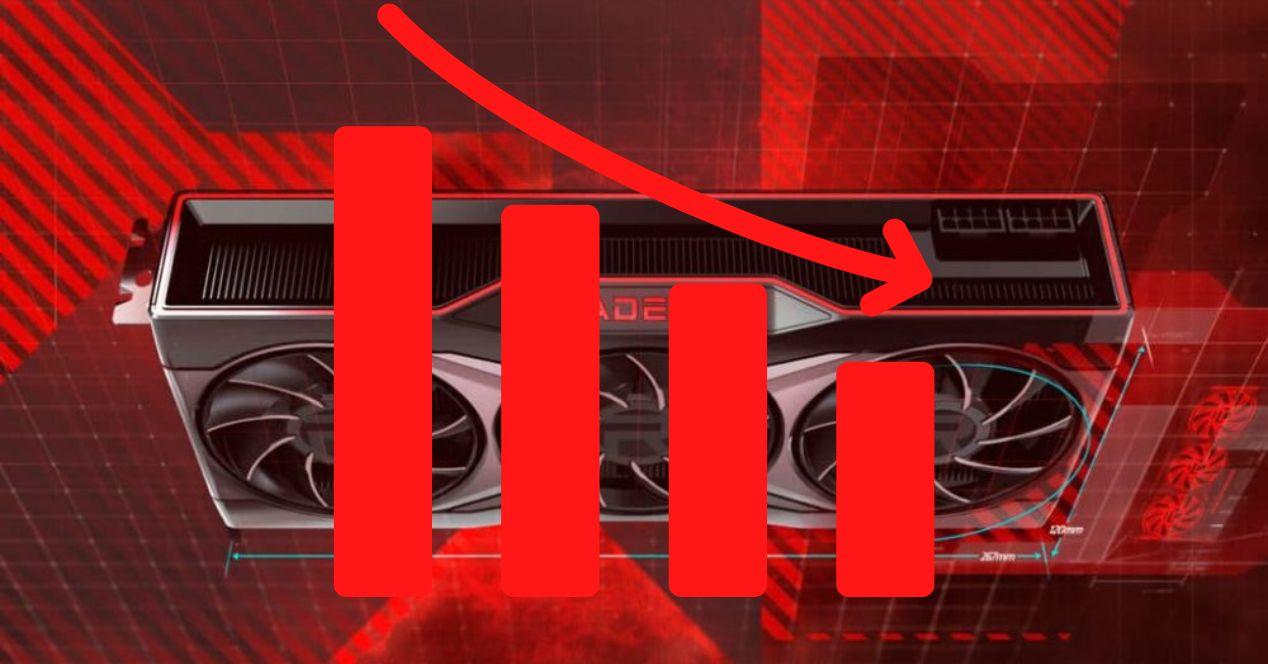2022 has become a dark year for the gaming GPU market, not only due to the side effects of the mining bubble and its demise, but also due to the impact of COVID-19 on the economy. However, we are not going to speak this time of the general situation, but of the plight of AMD graphics cards. And it is that, without wanting to be destructive, despite its excellent graphics cards, things do not look good for the Radeon house
The current situation in the AMD graphics card market is worrying. NVIDIA’s dominance in the market is absolute and they seem to be unopposed, allowing them to do whatever they want. We have already seen this a few years ago with an AMD out of action in the processor market and an Intel which rested on its laurels for a few years, giving it an advantage over its biggest rival. However, this did not happen with the GeForce and the Radeon was not the same as with the Ryzen. And no, we’re not saying it just to say it, we’re referring to sales and market share figures.
2022 has been disastrous for AMD graphics cards
The sum of all dedicated graphics cards that were sold in 2022 is 6.9 million in 2022, in terms of gaming laptops with dedicated graphics chip and memory, the figure is 7.1 million, this which makes a total of 14 million units. A figure that is the lowest since 2005. However, we must learn to differentiate between units sold and distributed. The former are those in the possession of end users, the latter those in retail stores and warehouses.
Yes, we break it down by brand, and starting with AMD graphics cards, we see that in the first quarter of 2022, 3.21 million units were distributed, in the second, 2.07 million, and in the third, only 0.69 million. Making Q3 one of the worst for Radeon, although it may be influenced. As for Intel, we don’t even need to mention that the launch of its A770 was more of a game of lights and smoke.
Instead, demand for NVIDIA remains very strong, and they are massively establishing themselves as industry leaders. And we don’t say it just to say, it was only in the first quarter of 2022 that those of Jen Hsen Huang distributed 10.04 million graphics cards, to distribute 8.25 million in the second and 5.93 million at the third. All of this is bad news for Lisa Su’s brand, which has the backing of console chip sales, but with much lower margins than PCs.
AMD’s mistake: making Ryzen compete with Radeon
Having more market share also means having more mental share and there fore being able to get more money from users to implement new features on your future graphics cards. Even if the key to NVIDIA’s success comes from the way they present their new generations and that they do not compete with each other when manufacturing the chips. On the other hand, AMD graphics cards do not and this is one of the big problems.
For your understanding, AMD has put so many products under one manufacturing node that their Ryzen and Radeon often compete for the same manufacturing resources. For Lisa Su’s company, the manufacture of graphics cards is not their main activity, but a completely secondary activity. All this leads to the fact that although their cards are of good quality and quite good, they have less resources and this results in the inability to manufacture models at the same time which has caused the existence of a monopoly in fact for NVIDIA which in recent quarters has reached nearly 90% market share.
And what happens when a manufacturer has so much power? Well, that translates into price gouging for the end user. The competition from NVIDIA is not strong enough and it affects all of us and that’s why it’s a big problem that has consequences on many levels.
This situation is bad for the PC Gaming market
Now, in order to maintain its competitive advantage, NVIDIA has no choice but to increase the prices of its graphics cards, which it can do due to the huge market share it has. This is all because it is increasingly expensive to design and manufacture hardware, and users need a high volume of purchases to spread and alleviate those costs. The result, if not achieved, are graphics cards at prices that were unthinkable a few years ago, which is happening today.
In PC games, this means that the adoption of new technologies is delayed, as is the case with Ray Tracing, which, after almost five years since its launch, is considered something optional and unnecessary. . To be useless? No, because most PC graphics cards can’t run it and that’s been NVIDIA’s bet all this time. All this causes a cycle in which users who play games on their PC do not need to renew their graphics card.
Oddly enough, the only one that launched a graphics card for this segment recently is Intel, but its ARC A770 pretends it doesn’t exist, it’s impossible to find, and a large part of the public doesn’t know it exists. All they know is that there are over $1,000 worth of graphics cards just released. He looks at them, sees their price and passes.
AMD graphics cards are the kings of the console
Additionally, NVIDIA and AMD should learn once and for all that not everyone is willing to pay the equivalent of a mortgage or rent on a graphics card. On the contrary, the biggest competition for their gaming GPUs is game consoles which are the main alternative and the main rival. That is to say, they do not compete with the other brand, but for the time spent playing by the users.
And that’s where the problem we have appears where it looks like the console market for AMD has been split, excluding the Nintendo Switch, and the PC market for NVIDIA. The red brand knows very well that it is more likely to sell the PS5 or Xbox chip than its Radeon chip and they have preference. It’s not just that fewer units are being distributed due to less demand, it’s that the three-letter manufacturer itself is making fewer PC units to prioritize consoles where they have juicy contracts with SONY and Microsoft which are a continuous source of money for years.
Table of Contents











